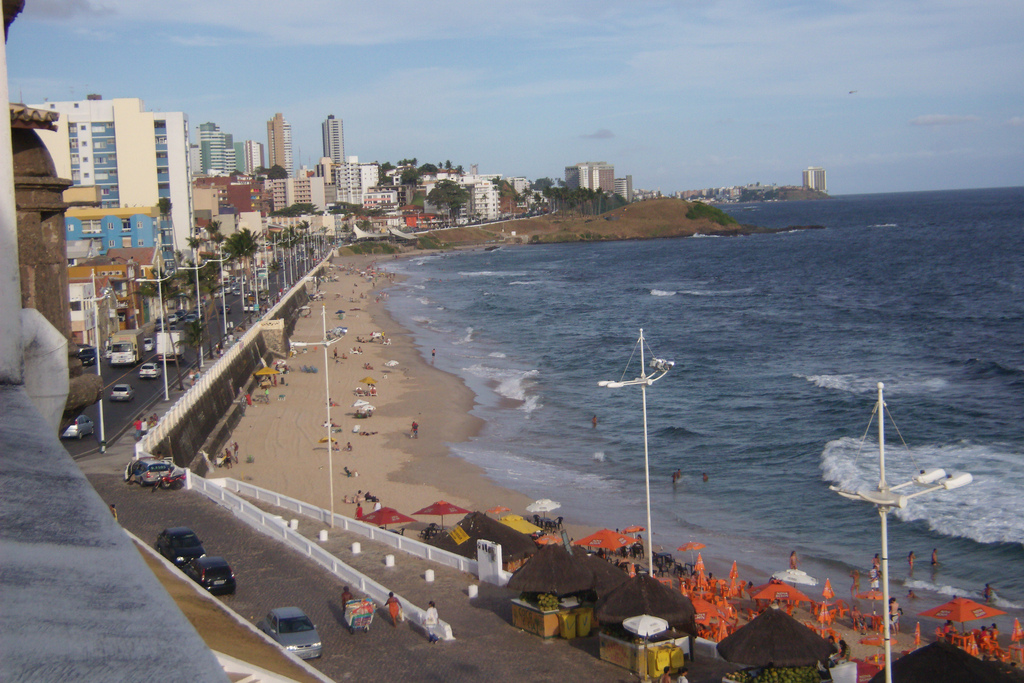
Praia do Farol da Barra. Photo © Roberto Sabino, licensed Creative Commons Attribution.
At the end of Corredor de Vitória—bracketed by a McDonald’s on one side and the gleaming white Igreja de Nossa Senhora da Vitória—the descent from Avenida Sete de Setembro begins a steep plunge toward the lively middle-class neighborhood and beach of Barra. This road, known as Ladeira da Barra, offers spectacular sea views that will surely whet your appetite for the beaches waiting at the foot of the hill. On your way down, you’ll pass Bahia’s yacht club, with its swan-like array of sailboats, the Cimetério dos Ingleses, where Bahia’s Brit expat community encountered a terribly scenic resting place, and, perched on a verdant hill, the 16th-century Igreja de Santo Antônio da Barra.At the bottom of Ladeira da Barra, you’ll find yourself in front of Salvador’s most famous beach, Porto da Barra, dramatically framed by two 17th-century Portuguese fortresses: Forte São Diogo and Forte Santa Maria. More than just a small crescent-shaped golden sand beach, “Porto” is an entire microcosm uniting families, gays, tourists, locals, vendors, hustlers, lovers, celebrities, sun worshippers, and volleyball and frescoball aficionados on one vibrant and colorful strip of sand bathed by the calm and surprisingly clear sea. Barring the rainy season, no matter how overpopulated it gets, Porto’s waters are always miraculously crystalline.
In the summer, Porto gets so packed it’s hard to see the sand, but as a social scene, it’s fascinating.In the summer, Porto gets so packed it’s hard to see the sand, but as a social scene, it’s fascinating. In the “winter,” locals tend to shy away, citing the cold as an excuse (as if anyone could get hypothermia when the thermometer falls to 24°C/75°F), leaving the beach deliciously empty. Although Porto has a small-town feel to it—aided by the fact that the only vessels bobbing on its waters are brightly painted wooden fishing boats—it packs a surprisingly urban wallop. While you’re hanging out, you’ll be bombarded by the songs and chants of passing vendors hawking everything from handmade jewelry (some of it quite inspired) and portable radios to skewered shrimp, grilled cheese (queijo coalho) with oregano, and fresh fruit popsicles called picolés (the best ones are made by a company called Capelinha). You’ll also be spoiled: After renting a beach chair and giant parasol, you’ll have your feet regularly refreshed with a watering can and all your drink requests attended to.Porto da Barra is the classic place to watch the sunset—in fact, applause rings out the moment the glowing orange-red disk descends below the Ilha da Itaparica, bathing both sky and sea in a painterly blaze of colors. (On Friday nights in summer, sunset is accompanied by free outdoor concerts). Since the beach is lit at night, it is possible to take a moonlight dip. However, be very careful with your valuables (even more so than during the day) since tourists are often targeted by thieves.
Walking along the breezy seaside promenade—past small coves and the increasing number of hotels, gyms, cybercafés, and bars that are turning Barra into a small-scale Copacabana—you’ll soon reach the iconic black-and-white striped Barra lighthouse. Jutting out into the sea at the point where the Bay of All Saints meets the Atlantic, the Farol da Barra is lodged within the 17th-century Forte de Santo Antônio. Although the current lighthouse, constructed of iron, was built in 1836, the original wooden one—dating from 1696—operated using whale oil and was the first lighthouse in all of the Americas. Inside the fort is the mildly interesting Museu Naútico da Bahia (tel. 71/3264-3296, 9 a.m.–7 p.m. Tues.–Sun., R$6), with a collection of maps, navigation instruments, model ships, and other seafaring paraphernalia. Just as interesting, if not more, is the secluded bar situated within the lighthouse’s sun-bleached walls. During the year, the Farol and surrounding area are the setting for various shows and concerts, the biggest of which occur on New Year’s Eve and Day.
Barra is where what Soteropolitanos refer to as the orla, or coastline, begins: a long string—roughly 20 kilometers (12.5 miles)—of beaches that stretch north to Itapuã and the city limits. Aside from Rio Vermelho, the adjoining neighborhoods themselves are of little interest, and if you’re looking for good beaches, the ones farther away, beginning at Boca do Rio, are the only worthy candidates for bathing. Lots of buses—both municipal and more expensive and air-conditioned executivos—leave from the center (Campo Grande and Lapa) or from Barra and speed up and down the coast all the way to Itapuã. On the weekends, particularly in the summer, all of these beaches get really packed. It’s best if you can go early and come back at around 3 p.m. to beat the rush and crush.
Excerpted from the First Edition of Moon Living Abroad in Brazil.